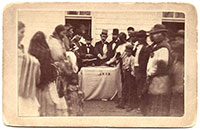U.S. Treaties with the Ojibwe or Chippewa of the Fond du Lac region
The Ojibwe people of the Fond du Lac and Lake Superior region had dealings with European governments for hundreds of years before the arrival of representatives of the United States government after the War of 1812. In the years following, a number of treaties were negotiated between the Ojibwe and the United States, first to establish a peaceful relationship and then to transfer title of lands to the United States. Links to the text of these treaties are given below, to an online version of an official federal source, maintained by the University of Oklahoma.
1825, Treaty at Prairie du Chien, Wisconsin. Treaty Text Link
This was the first treaty for many Native Groups in the region of Lake Superior and Upper Mississippi. Its major purpose was to establish peace between the various tribes and the government and to set boundaries between the territories of various groups so that the United States government could negotiate with each, in turn, to buy their lands. Among the signers were Chief Buffalo of La Pointe and chiefs from Fond du Lacs and many other places in Minnesota and Wisconsin.
1826 Treaty of Fond du Lac. Treaty Text Link
This treaty held in the area of the village and trading post in the Fond du Lac neighborhood of Duluth, was a called to achieve full accord with all the Ojibwe bands in the region about the treaty of Prairie du Chien, since some band leaders who had not been able to attend the earlier treaty. It also gave the U.S. government the right to search for minerals in the Lake Superior Region. Chief Buffalo was there, as well as many other chiefs in the region.
1837 Treaty of St. Peters. Treaty Text Link
This treaty was held at Fort Snelling at the junction of the Mississippi and Minnesota Rivers. The chief purpose of the treaty was for the United States to obtain title to lands across central Minnesota and Wisconsin, containing pine forests which Americans were eager to log. Among the signers were Chief Shin-go-be (Spruce) and Chief Loon’s Foot of Fond du Lac band. The treaty was not signed by Ojibwe band delegations until Chief Buffalo arrived from La Point, a tribute to his stature in the region. Because most of the Ojibwe did not want to leave their lands and were willing to let the pine be logged, the treaty provided for their continued residence in the region and stated that:
The privilege of hunting, fishing, and gathering the wild rice, upon the lands, the rivers and the lakes included in the territory ceded, is guarantied to the Indians, during the pleasure of the President of the United States.
This provision was the subject of much litigation, culminating in a U.S. Supreme Court decision in 1999 which affirmed the continuing existence of these reserved rights.
1842 Treaty of La Pointe. Treaty Text Link
The treaty was motivated by a desire on the part of Americans to mine for copper in the broad area along the south shore of Lake Superior. Like the 1837 treaty, this one foresaw the continuing residence of Ojibwe people in the ceded region stating:
The Indians stipulate for the right of hunting on the ceded territory, with the other usual privileges of occupancy, until required to remove by the President of the United States, and that the laws of the United States shall be continued in force, in respect to their trade and inter course with the whites, until otherwise ordered by Congress.
These reserved rights have been affirmed in several federal court cases.
1847 Treaty of Fond du Lac. Treaty Text Link
This was the first of two treaties for the purpose of acquiring land along the Mississippi, near Long Prairie, for residence of the Ho-Chunk, then known to whites as the Winngebago, who were being removed from their homelands in Wisconsin. The first treaty obtained the consent of Lake Superior and some Mississippi bands of Ojbwe. The second treaty was with the Leech Lake Pillagers and was signed at Leech Lake.
1854 Treaty of La Pointe. Treaty Text Link
This treaty provided for transferring land title to lands in the Arrowhead region, northeastern Minnesota. At the same time the treaty created reservations for the permanent residence of Ojibwe people throughout the land ceded in this and previous treaties. This was also the treaty in which Chief Buffalo reserved lands for himself in what became the city of Duluth. The treaty also assumed that many would not be required to remove from ceded lands and stated that:
such of them as reside in the territory hereby ceded, shall have the right to hunt and fish therein, until otherwise ordered by the President.
Like the rights reserved in the 1837 and 1842 treaties, these rights have been affirmed by federal courts. Later events show that though the reservations created by this and other treaties were designed to be permanent, efforts were made by government leaders, logging companies, and others to undermine their permanence and misconstrue their boundaries.
Associated Images
click for larger image with caption
Copyright © 2022. All rights reserved.




